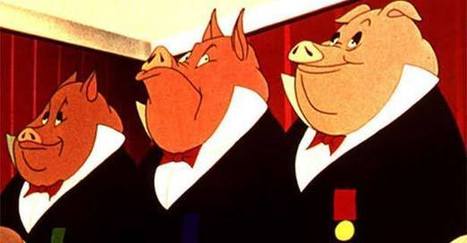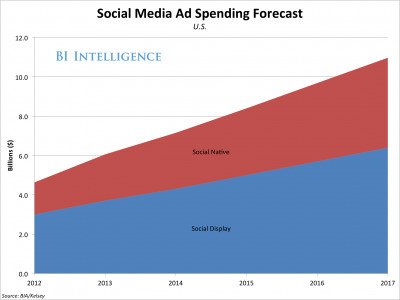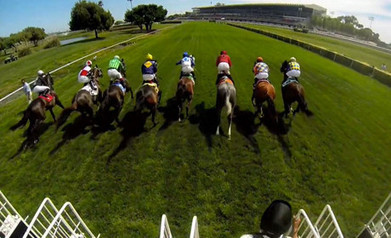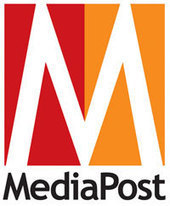 Your new post is loading...
 Your new post is loading...
Every publisher today wants to wean themselves off display advertising. For mid-sized publishers relying on banners won’t cut it. Slate has made this is a priority, and it now says native ads are almost half of its total revenue.
The online politics and culture publication accomplished this with putting native at the center of its sales strategy rather than treating it as an add-on. Advertising supplies 90 percent of revenue, and native is half of that. Display and podcast advertising still accounts for the other half, although Slate expects display dollars to move towards programmatic, following the industry shift. (The remaining 10 percent comes from other sources like the Slate Plus membership program.)
To prioritize native, Slate hired or retrained its 10-person sales team. Slate Custom, the custom ad creation unit, brought in a new staff under Jim Lehnhoff, the former head of Gawker Media’s content strategy. The 13-person custom unit now focuses on making native ads that are closer to Slate’s editorial DNA of smart commentary. Slate also got more aggressive about buying off-site distribution for the ads, for clients like Jaguar and Chase....
Today's fragmented media landscape and information-loaded digital world offer brands new opportunities to communicate directly with their audiences—building visibility, affinity and even search traction along the way.
However, success in the uppermost reaches of the funnel requires organizations to put the corporate agenda in the back seat, adopting instead a more journalistic approach to crafting and publishing their stories.
Enter brand journalism.
Not to be confused with content marketing, brand journalism is an upper-funnel tactic that delivers more than mere brand awareness. Telling the brand's stories in a compelling, audience-focused way can create affinity, earn media coverage, build brand credibility and (when coupled with search and social strategies) deliver long-lasting online visibility.
...Spark and its sibling branded content and entertainment division LiquidThread and Genworth are launching an integrated partnership with CNN that makes Genworth the first advertiser to use CNN’s Content Development Studio, a unit under the network that works with advertisers and agencies to develop branded entertainment and sponsored programming.
Under the deal, Spark worked with the CNN production team to develop new informational brand creative -- both :15 and :60 second versions -- to convey the importance of planning for the future. "CNN was immensely collaborative and it is useful to use their voice to lend credibility to the conversation," says Levin.
At the same time, CNN is publishing a series of articles to educate Genworth's target Boomer audience about the importance of long-term care planning and best practices to prepare for their future. These articles will run on CNN's online channels as sponsored and organic content.....
...I don’t know if the guy owned stock in Second Life, or was shacking up with the founder’s daughter, or if his Second Life avatar owned the biggest fake ad agency in that big fake world and he planned to corner the Second Life fake ad market.
All I know is that he made it clear. Laid it bare. If we weren’t building campaigns to include a serious presence on Second Life, we were doomed. DOOMED!And so today, whenever I hear someone declare that the future of digital advertising is native ads, all I hear is Second Life. And all I smell is poo....
Online advertising has grown exponentially since its foundation in the 90s. Now, online ad sales make up the majority of the industry, and savvy companies are directing the lion’s share of their budgets at the digital space.
Advertising through social media is nothing new, but so far, brands have been playing it safe, using many of the same methods that have already been successful in the past – combining banner- and text-link-style ads in news feeds and sidebars. But the possibilities of social advertising have yet to be fully explored.
The real power comes not from the reach of a company’s network, but from getting that company’s customers to do the outreach FOR them.
Social media is changing the way people view and interact with content online. While the idea of a website “page” has been a vital component in the way people understand the web, the use of feed-based content in Facebook, Twitter and Instagram has changed the concept of what a website IS. ....
It’s the latest craze, the emerging brand sponsored content site where companies pump out content off of their corporate website with the hopes of connecting to their target consumer in a way that doesn’t feel “Salesy.”
Visit sites like Forbes or Inc. and find brand sponsored content from global companies like SAP, Disney and EMC where the line between the pieces being native and advertisements is so thin that it could slide under a closed door.
This trend doesn’t root in hunches or guesses, it roots in truth; people trust content when it informs and educates and that is what these brands are doing, only they are doing it so intelligently that they have created the newest form of media company…
Content marketing costs less than advertising, and more people engage with it.It sounds like a revolution but actually there are some rather unkind hidden truths in all of this.
Much like the pigs at the end of Animal Farm, with the evil predecessor gone, what’s replaced it looks… very similar indeed.George Orwell, Animal Farm: "Twelve voices were shouting in anger, and they were all alike. No question, now, what had happened to the faces of the pigs. The creatures outside looked from pig to man, and from man to pig, and from pig to man again; but already it was impossible to say which was which..."
Facebook, Twitter, Pinterest are all moving to native ads. The native-social rush is on.
BIA/Kelsey estimates that social ad spend will reach over $10 billion by 2017 and that up to 40% or more of those outlays will go to native ads. In the social context, we define native ads as ads that are seamlessly integrated into a user's feed and are nearly indistinguishable from organic content.
...On Facebook, native ads in the News Feed generate 49-times higher click-through rates and a 54% lower cost-per-click than traditional placements in the right-rail sidebar. LinkedIn is making major investments in its native strategy and Pinterest is piloting native ads on its platform.
According to Jan Rezab, CEO of Socialbakers, a social media analytics company that works with Fortune 100 brands, "In the future, all advertising on social media will be native in-stream ads. The right rail and banners will disappear altogether."...
We speak to two of the people involved in creating the news outlet's latest Snowfall-like immersive multimedia project....
Last week The New York Times website published a story called The Jockey, followed by publication in the sports section of the print edition on Sunday.
The Jockey is the latest immersive or multimedia reading experience created by the news outlet that brought us Snow Fall. The Jockey tells the story of Russell Baze, the first North American jockey to ride in 50,000 races, and does so through long-form text, video and moving graphics.This immersive story has a sponsor. Some have interpreted this as native advertising or sponsored content, and AdAge writes that these custom ad units are "designed to better fit the new environment" than the advertising within Snow Fall...-
For an upcoming magazine column on the intersection of technology and publishing, I interviewed a number of smart thinkers about how brands should be self-organizing to create engaging, provoking, and ethical content (as opposed to inane social media filler).
One of the interviews I conducted was with Neil Chase, former New York Times editor and SVP at Federated Media, now a content strategy consultant (and friend). He had a lot to say on the subject of brand publishing — more than I can fit into my column — and I think every company ought to take heed. So I decided to post our conversation in its entirety....
While Twitter and texting appear to be reducing our communications skills to the level of a grunt, there has been a spate of TV spots in which the power of the long copy has been applauded by the industry, consumers and award juries alike.
Spots like the multi-lauded “Born of Fire” spot for Chrysler by Wieden +Kennedy, which gave Detroit, a city considered lost for decades now, something to be proud of. These words didn’t just sell a car, they uplifted an entire city.I remember watching this ad in the jury room in Cannes and feeling the hairs on my arm stand up. It was also interesting that the power of the words were not lost on the international jury. Jokes and special effects used to be the way to win at Cannes. Maybe not so anymore....
...Effectiveness of longform So the question we all have about these beautiful layouts. Does it work? Is it more engaging? How do we know? Though Brundrett didn’t have exact numbers to provide, he said their numbers have grown and the audience has developed higher expectations for what they produce.
“We get really great traffic to these pieces, off the charts engaged time, people are reading all the way down the page, great comments and discussion,” Brundrett said. “From a social perspective they get shared like crazy . They do really well for us.”...
In the age of brand storytelling, here are the 5 basic rules for picking the right content agency to tell your brand’s story.... Content creation now is the biggest challenge of 21st century marketing. It’s time-consuming and complicated. Most startling to ad people, it requires a creative and strategic mindset that is alien to life-long inhabitants of adland. I still find myself explaining to agency people, for example, that good brand content must be ownable and original. Re-running content from well known magazines doesn’t build your brand, it spreads the magazines’ brands. Imitating others’ great content will sell about as well as Karaoke versions of classic hit songs. “Native advertising” that’s really just offensively self-serving advertorial will both fail and embarrass. (For more on “native,” look at Native advertising will fail if it means ‘Let’s lie to the natives.’) Get brand content wrong and you can generate incredible brand damage. (Ask Fleet Laboratories’ Summer’s Eve “feminine wash,” Nestlé’s Kit Kat brand and many, many others.) But get it right and you generate legions of fans who promote your brand with more credibility, less cost and far greater effectiveness than you could ever muster with traditional ads. This is the enormous pot of gold at the end of the content rainbow. (Ask Ford Fiesta or a host of Story clients, including WGN America, and others.)...
|
Native Insider: Part of the challenge with "native" is that each organization has a different understanding of what it is. For the purposes of the research, what is your definition of native advertising?
Wu: In our study, we defined native advertising as sponsored content, which features content that is similar and consistent with publishers’ content and is often consumed by readers like non-sponsored content. I agree that there are also other types of native advertising, such as sponsored social media posts or sponsored hyperlinks. We focused on sponsored content because it is widely adopted by many news organizations, including very reputable ones like The New York Times.
Native Insider: Your research found that when content was identified as native advertising, readers expressed a lower opinion of the media outlet it was published in. However, the reputation of the company being promoted was not affected. Can you elaborate on this finding?
Wu: I think this was one of the most interesting findings in our study. We originally expected that both companies and media outlets would be negatively influenced. However, the media outlet was the only source that was affected. On one hand, this indicates that readers are not surprised by the sponsored content from a company, since similar covert marketing techniques have been utilized before, such as video news releases....
Native is one of the hottest topics in digital media, and advertisers and publishers are taking notice.
By creating advertisements that are in the same format as the content audiences are there to consume, marketers hope to provide a much less disruptive advertising experience. Native ads have also proven effective, drawing higher click rates than traditional banner ads, particularly on mobile devices.
New and exclusive data from BI Intelligence finds that spending on native ads will reach $7.9 billion this year and grow to $21 billion in 2018, rising from just $4.7 billion in 2013. We are the only research service that has provided a detailed breakdown of spend projections and growth rates for each of the three main native ad types — social-native, native-style display ads, and sponsored content. ...
At a time when good-paying freelance assignments are harder to come by, many journalists are heeding the call of native advertising, where the pay is decent and the work is steady. But there’s a cost. Many worry about the impact on their credibility as a journalist. Some are even finding they aren’t so welcome back in newsrooms once they work for the business side.
In the latest in Digiday’s “Confessions” series, we talked to a veteran freelance writer who has written for top women’s magazines and other national publications about the dark side of native. In this case, the journalist was working for a publisher’s content studio, which assigned stories a given client wanted written....
Programmatic advertising may be the sexy new buzz phrase, but more automation can lead to more clutter. When it comes to paid media on the web, the best way forward is to have fewer ads.
Native advertising is paid content that matches a publication’s editorial standards while meeting the audience’s expectations.
Think Captain Morgan’s campaign on BuzzFeed in general, their 15 Things You Didn’t Know About 15 Captains, Commanders And Conquerors article in particular.
First off, the theme of the article matches the brand’s values: Captain Morgan was a real live pirate who thrived on adventure and raw conquest — a theme not too foreign to BuzzFeed readers.
Moreover, the article matches the editorial standards of BuzzFeed: a list with big images and short, quirky copy — a format their audience expects....
For as long as there’s been media, there has been a revolving door between newspapers, magazines and PR firms,” said Evan Hansen, senior editor at Medium. “As far as that goes, nothing is new.”
Hansen should know. He recently walked through that door himself, departing as Wired.com’s editor in chief to put down stakes in the land of content. While the path he took has been traveled by journalists before him, it’s undeniable that something has changed. Brands are luring away big names in journalism — Newsweek’s Dan Lyons and Melissa Lafsky Wall, PandoDaily’s Hamish McKenzie, Wired’s Michael Copeland, USA Today’s Michelle Kessler – and these writers aren’t churning out press releases; they’re still telling stories....
Go big or go home, right? Brands everywhere are going over the top to impress consumers and grab their attention. To do this, they’re coupling pranks with video advertising strategies to create compelling content that goes viral. While some marvel at the creativity, others argue that prankvertising goes too far. Regardless, the power of the latest trend in video advertising is undeniable. Here are some of our favorite prankvertisements.
In preparation for one of CMI’s upcoming reports, I’ve had the pleasure of meeting with a number of companies that are in what’s being called the “native advertising” space. Through this experience, I’ve come to the conclusion that, while the technique can potentially create significant value, native advertising is actually neither “native” nor “advertising.” It is simply one aspect of the larger discipline we know of as branded content marketing. Native by any other name According to Wikipedia (which I chose not because of, you know, Wikipedia, but because it seemed to be the only place offering one up), native advertising is defined as: “…a method in which the advertiser attempts to gain attention by providing valuable content in the context of the user’s experience. Native ad formats match both the form and the function of the user experience in which it is placed.”
In short, native advertising takes content and places it in the context of a publisher’s site. So, whether you think of it as an advertorial, a paid guest post, a sponsored tweet, or just a really extensive ad, it’s basically paying for your engaging branded content to have a prominent and contextual place on somebody else’s platform.
An interactive media feature showing Hewlett-Packard's new shipping corridor along the route of the ancient Silk Road.
Via Marie-Sophie
I think advertisers are smart to want to have their ad copy look, read, and sound more like journalism. It’s a form of flattery for what we do, and although trust has waned in our profession recently—the public sees that our journalism is not as good as it used to be–it means that at least that the Mad Men of Madison Avenue think we’re more trustworthy than they are.
There’s an informative website, brandjournalists.com, that explains what these new kinds of ad producers do and why. It’s instructive.At base what they say they are doing is story telling. And, as they say, a good story is the essence of human communication. We journalists know that, or at least we should. If you can tell a good story about a company or organization, that’s likely to sell more product than the best old-hat sales pitch, the brand journalists reason.
They’re right. I agree with the ad folks that most companies have a good story to tell. I used to cover business and I never found a business I couldn’t find something interesting and newsworthy to write about.But let me show you how journalism is different than “brand journalism” or other kinds of sponsored content. This story you might even know....
A recent study conducted by BIA / Kelsey predicts that by 2017, social media advertising spending will have reached 11 billion dollars; a significant growth compared to 4.7 billion dollars last year. Business owners and investors are excited with this huge growth, but according to Ian Schafer, chief executive of Deep Focus, a full-service, interactive marketing agency, the ad agency may not be ready to deliver when 2017 comes.
Schafer points out the study conducted by YouGov, which showed that last year, only one out of 20 users in Facebook clicked at least one advertisement. In addition, less than ten percent of Facebook users think that targeted ads are relevant to their needs. One reason why Facebook ads have such a negative impact on users is because they appear to march into our private social media space, sending us spam messages, mobile banners, occupying the right side of our profiles, forcing us to watch 15 second video ads, and more....
The noise around brand journalism these days is deafening. Unfortunately, a lot of it is based on poor practices or wrong information. We need to toss the marketing and get back to creating great content.
As in irresistible content. Content that shares real news, tells stories, solves problems, informs, educates and connects with consumers.
You know. Kind of rhymes with journalism?...
|
 Your new post is loading...
Your new post is loading...
 Your new post is loading...
Your new post is loading...











































Native advertising starts to gain hold at Slate.